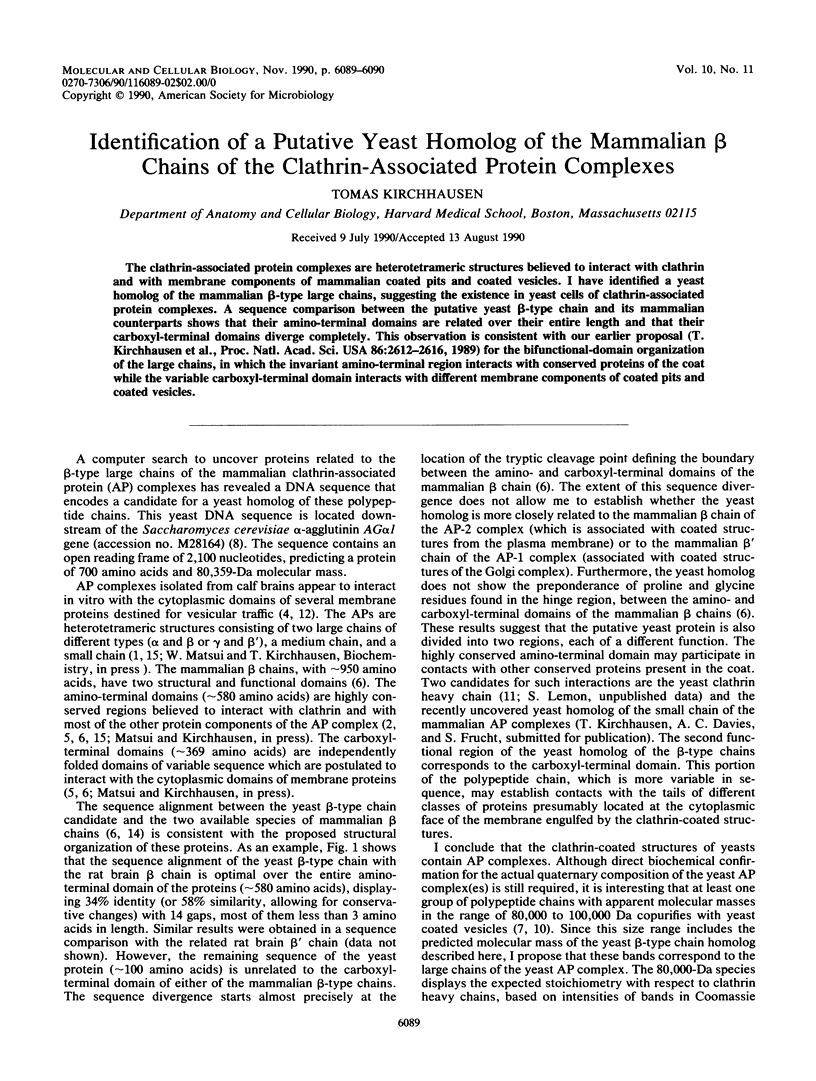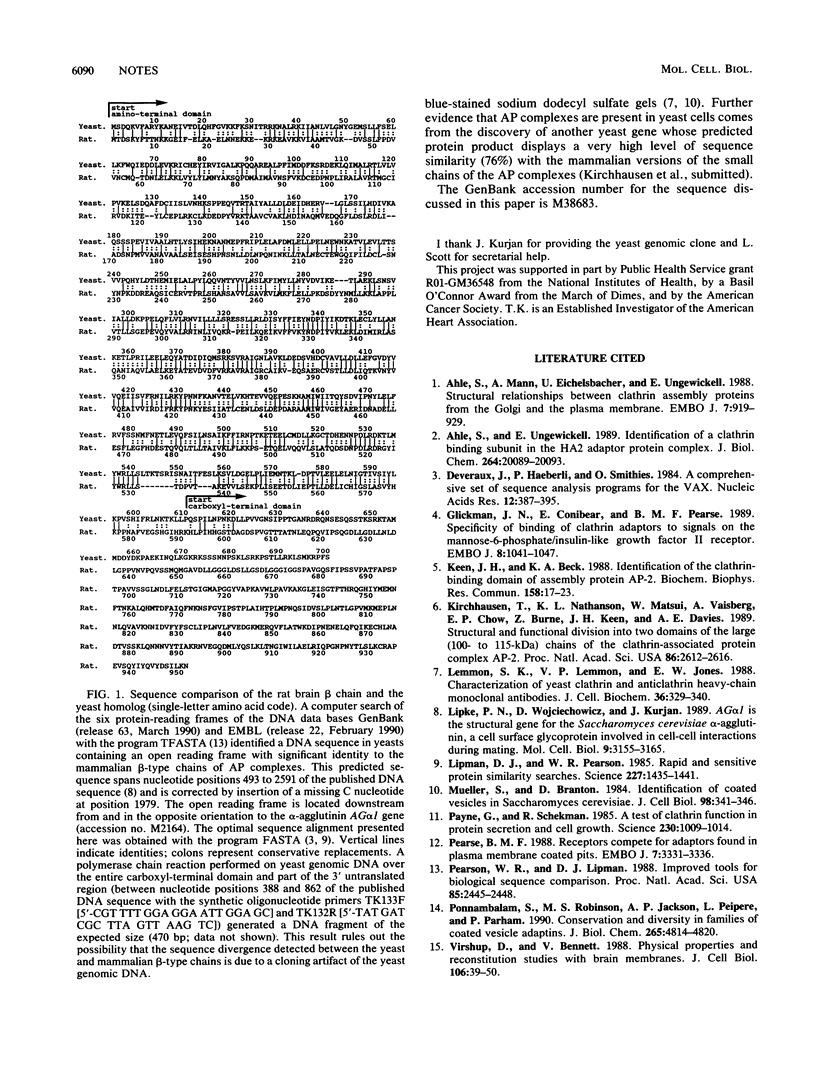Abstract
The clathrin-associated protein complexes are heterotetrameric structures believed to interact with clathrin and with membrane components of mammalian coated pits and coated vesicles. I have identified a yeast homolog of the mammalian beta-type large chains, suggesting the existence in yeast cells of clathrin-associated protein complexes. A sequence comparison between the putative yeast beta-type chain and its mammalian counterparts shows that their amino-terminal domains are related over their entire length and that their carboxyl-terminal domains diverge completely. This observation is consistent with our earlier proposal (T. Kurchhausen et al., Proc. Natl. Acad. Sci. USA 86:2612-2616, 1989) for the bifunctional-domain organization of the large chains, in which the invariant amino-terminal region interacts with conserved proteins of the coat while the variable carboxyl-terminal domain interacts with different membrane components of coated pits and coated vesicles.
Full text
PDF

Selected References
These references are in PubMed. This may not be the complete list of references from this article.
- Ahle S., Mann A., Eichelsbacher U., Ungewickell E. Structural relationships between clathrin assembly proteins from the Golgi and the plasma membrane. EMBO J. 1988 Apr;7(4):919–929. doi: 10.1002/j.1460-2075.1988.tb02897.x. [DOI] [PMC free article] [PubMed] [Google Scholar]
- Ahle S., Ungewickell E. Identification of a clathrin binding subunit in the HA2 adaptor protein complex. J Biol Chem. 1989 Nov 25;264(33):20089–20093. [PubMed] [Google Scholar]
- Devereux J., Haeberli P., Smithies O. A comprehensive set of sequence analysis programs for the VAX. Nucleic Acids Res. 1984 Jan 11;12(1 Pt 1):387–395. doi: 10.1093/nar/12.1part1.387. [DOI] [PMC free article] [PubMed] [Google Scholar]
- Glickman J. N., Conibear E., Pearse B. M. Specificity of binding of clathrin adaptors to signals on the mannose-6-phosphate/insulin-like growth factor II receptor. EMBO J. 1989 Apr;8(4):1041–1047. doi: 10.1002/j.1460-2075.1989.tb03471.x. [DOI] [PMC free article] [PubMed] [Google Scholar]
- Keen J. H., Beck K. A. Identification of the clathrin-binding domain of assembly protein AP-2. Biochem Biophys Res Commun. 1989 Jan 16;158(1):17–23. doi: 10.1016/s0006-291x(89)80170-6. [DOI] [PubMed] [Google Scholar]
- Kirchhausen T., Nathanson K. L., Matsui W., Vaisberg A., Chow E. P., Burne C., Keen J. H., Davis A. E. Structural and functional division into two domains of the large (100- to 115-kDa) chains of the clathrin-associated protein complex AP-2. Proc Natl Acad Sci U S A. 1989 Apr;86(8):2612–2616. doi: 10.1073/pnas.86.8.2612. [DOI] [PMC free article] [PubMed] [Google Scholar]
- Lemmon S., Lemmon V. P., Jones E. W. Characterization of yeast clathrin and anticlathrin heavy-chain monoclonal antibodies. J Cell Biochem. 1988 Apr;36(4):329–340. doi: 10.1002/jcb.240360403. [DOI] [PubMed] [Google Scholar]
- Lipke P. N., Wojciechowicz D., Kurjan J. AG alpha 1 is the structural gene for the Saccharomyces cerevisiae alpha-agglutinin, a cell surface glycoprotein involved in cell-cell interactions during mating. Mol Cell Biol. 1989 Aug;9(8):3155–3165. doi: 10.1128/mcb.9.8.3155. [DOI] [PMC free article] [PubMed] [Google Scholar]
- Lipman D. J., Pearson W. R. Rapid and sensitive protein similarity searches. Science. 1985 Mar 22;227(4693):1435–1441. doi: 10.1126/science.2983426. [DOI] [PubMed] [Google Scholar]
- Mueller S. C., Branton D. Identification of coated vesicles in Saccharomyces cerevisiae. J Cell Biol. 1984 Jan;98(1):341–346. doi: 10.1083/jcb.98.1.341. [DOI] [PMC free article] [PubMed] [Google Scholar]
- Payne G. S., Schekman R. A test of clathrin function in protein secretion and cell growth. Science. 1985 Nov 29;230(4729):1009–1014. doi: 10.1126/science.2865811. [DOI] [PubMed] [Google Scholar]
- Pearse B. M. Receptors compete for adaptors found in plasma membrane coated pits. EMBO J. 1988 Nov;7(11):3331–3336. doi: 10.1002/j.1460-2075.1988.tb03204.x. [DOI] [PMC free article] [PubMed] [Google Scholar]
- Pearson W. R., Lipman D. J. Improved tools for biological sequence comparison. Proc Natl Acad Sci U S A. 1988 Apr;85(8):2444–2448. doi: 10.1073/pnas.85.8.2444. [DOI] [PMC free article] [PubMed] [Google Scholar]
- Ponnambalam S., Robinson M. S., Jackson A. P., Peiperl L., Parham P. Conservation and diversity in families of coated vesicle adaptins. J Biol Chem. 1990 Mar 25;265(9):4814–4820. [PubMed] [Google Scholar]
- Virshup D. M., Bennett V. Clathrin-coated vesicle assembly polypeptides: physical properties and reconstitution studies with brain membranes. J Cell Biol. 1988 Jan;106(1):39–50. doi: 10.1083/jcb.106.1.39. [DOI] [PMC free article] [PubMed] [Google Scholar]


